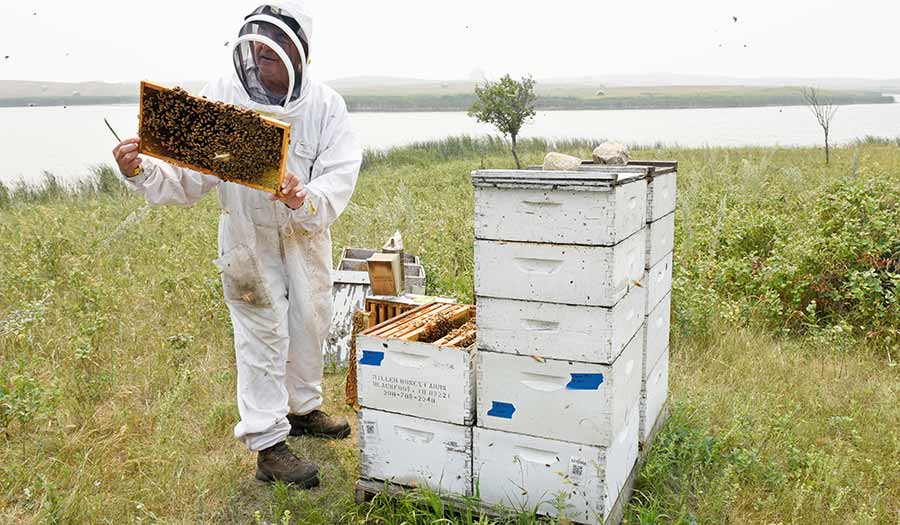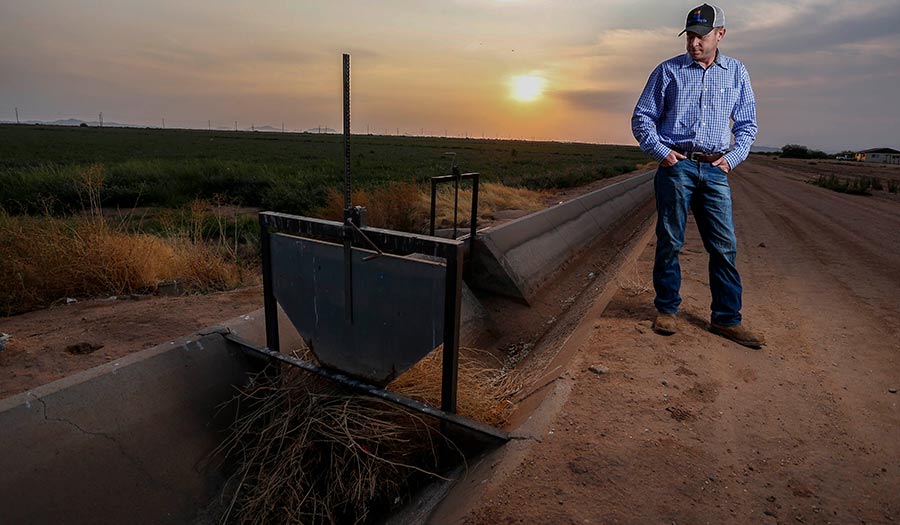 Reuters/Dan Koeck
Reuters/Dan Koeck
World News Desk
Learn the why behind the headlines.
Subscribe to the Real Truth for FREE news and analysis.
Subscribe NowGACKLE, North Dakota (Reuters) – There was barely a buzz in the air as John Miller pried the lid off of a crate, one of several “bee boxes” stacked in eight neat piles beside a cattle-grazing pasture outside Gackle, North Dakota.
“Nothing,” Mr. Miller said as he lifted a plastic hive frame from the box, squirming with only a few dozen bees. “Normally this would be dripping, full of honey. But not this year.”
A scorching drought is slashing honey production in North Dakota, the top producing state of the sweet syrup. That means fewer bees can thrive, which leads to even less honey.
The shortage of strong bee colonies, meanwhile, is putting West Coast cash crops like almonds, plums and apples at risk, according to more than a dozen interviews with farmers, bee experts, economists and farm industry groups.
Mr. Miller and other Midwestern apiarists haul their drought-weakened insects by truck to California almond farms in the winter to pollinate orchards in the top global producer of the nuts increasingly in demand for milk substitutes. Then they move on to other fruits.
The drought’s impact therefore will be felt far beyond North Dakota, where withered alfalfa fields and parched pastures usually teeming with sweet clover and gumweed are providing bees little nectar this summer.
The dearth of strong bee colonies and the resulting higher costs to lease them for pollination services will add to the challenges of West Coast growers already dealing with drought and, in California, soaring water costs. It could also add to soaring costs consumers are facing at grocery stores.
The 2.7 million managed honeybee colonies in the United States—one in five of them in North Dakota—are crucial to pollinating scores of crops, including cherries and peaches as well as almonds and apples. Income from pollination services totaled $254 million in 2020, according to U.S. government data.
Many beekeepers produce honey during summer in the northern Midwest and Plains, where bees forage on pastures and rangelands, harvesting what honey the bees do not consume or stow away to nourish their young.
North and South Dakota, Montana and Minnesota accounted for 46 percent of all U.S. honey production last year, according to the U.S. Department of Agriculture (USDA).
Apiarists truck the beehives to milder climates like California during the fall and winter, generating crucial income by leasing colonies to fruit and nut farms to pollinate crops.
Poor summer weather on the prairies has left colonies weakened, with fewer bees. A smaller amount of nectar also forces beekeepers to help feed their colonies with less nutritious sugar solution or corn syrup, an added expense for producers already hurt by a smaller honey harvest.
“What happens in North Dakota in August has a direct impact on what happens in California in February,” Mr. Miller said. “Weak colonies that lack sufficient stores of honey going into winter will not be in good shape for the upcoming almond bloom.”
Mr. Miller expects less than 30 pounds of harvestable honey per colony from his roughly 16,000 hives this summer, down from around 50 pounds in recent years and the least in his 52 years of records, as North Dakota suffers its worst drought since 1988, according to climatologists.
Higher Pollination Costs
California’s drought-hit almond growers, who account for around 80 percent of global production, may be in for a shock come September or October as they negotiate pollination contracts for the upcoming season, said agricultural economist Brittney Goodrich, at the University of California at Davis.
Almond growers required about 2.5 million colonies last year to pollinate acres that have more than doubled in the last 15 years as demand for almond milk and health foods has grown. That represented around 88 percent of all managed U.S. hives, Dr. Goodrich said, adding that supplies of strong hives will remain tight this year.
“This certainly has the potential to impact almond yields,” she said.
Pollination services are among the largest input costs for almond farms, and those costs are set to rise at least 5 to 10 percent for the upcoming season, said Denise Qualls, pollination broker and founder of brokerage The Pollination Connection.
Almond farmer Ben King has already seen his pollination cost rise from $210 per hive to $230 as demand for strong colonies has outpaced supply and beekeepers pass along their higher costs.
The drought, meanwhile, is tightening bee supplies further. Mr. King’s beekeeper will only guarantee him 675 hives for the upcoming season, down from the 700 he normally would rent for his groves near Arbuckle, California.
“Overall, you’re going to have less pollination because you’re going to have less hive strength,” he said. “Everybody is scrambling this year because of drought.”
- World News Desk
- WEATHER & ENVIRONMENT
 First Water Cuts in U.S. West Supply to Hammer Arizona Farmers
First Water Cuts in U.S. West Supply to Hammer Arizona Farmers
Other Related Items:
More on Related Topics:
- India’s Capital Chokes as Air Pollution Levels Hit 50 Times the Safe Limit
- Record-setting Dry Conditions Threaten More U.S. Wildfires, Drinking Water Supplies
- Death Toll from Spanish Floods Climbs as Shock Turns to Anger and Frustration
- Residents Slog Through Flooded Streets, Clear Debris After Hurricane Milton Tore Through Florida


